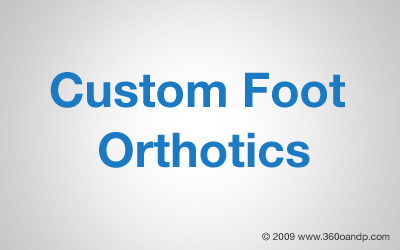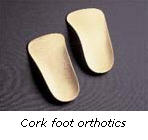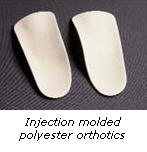
 To understand the complexity of the human foot and the biomechanics of ambulation and weight bearing, we must understand that as an individual ambulates, the pelvis, femur, tibia and fibula undergoes rotation in the transverse plane. This is transmitted through the ankle joint, through the subtalar joint and into the bones of the foot.
To understand the complexity of the human foot and the biomechanics of ambulation and weight bearing, we must understand that as an individual ambulates, the pelvis, femur, tibia and fibula undergoes rotation in the transverse plane. This is transmitted through the ankle joint, through the subtalar joint and into the bones of the foot.
The body requires a flexible foot to successfully adapt to our physical environment, i.e. flat, uneven or sloping surfaces, but requires a rigid structure for the push-off phase of the gait cycle.
 Many pathologies involving the foot and ankle can be addressed with various designs of the custom foot orthotic.
Many pathologies involving the foot and ankle can be addressed with various designs of the custom foot orthotic.
A custom foot orthotic is fabricated using a molded cast of the patient’s foot and/or an impression taken of the foot. This decision is made by your orthotist. From that cast or impression, a molded plastic foot orthotic which will conform to your individual foot pathology will be fabricated.
 Various materials can be used in the fabrication technique. The choice will depend on your individual needs. There are basically three levels of orthotic strength, i.e. mild, moderate and firm. The appropriate strength of material which will be best for your particular pathology will be used by your orthotist.
Various materials can be used in the fabrication technique. The choice will depend on your individual needs. There are basically three levels of orthotic strength, i.e. mild, moderate and firm. The appropriate strength of material which will be best for your particular pathology will be used by your orthotist.
Depending on the pathology of the foot, the support will be designed to address that particular pathology to produce a normally aligned foot with good weight bearing properties and lead to a comfortable and successful gait pattern.
ASSOCIATED CONDITIONS
Plantar Fasciitis
The plantar fascia originates at the plantar aspect of the calcaneus (heel bone) continuing forward to insert on the proximal phalanges (any one of the five bones of the toes). This plantar fascia, for many reasons, can be stretched and damaged leading to flattening of your arch and cause discomfort and difficulty ambulating properly. The foot orthotic design will aide in supporting the three arches of the foot in a neutral position.
Achilles Tendinitis
The orthotic design will support the foot in a neutral position of function and unload affected areas.
Morton’s Neuroma
The orthotic design will support the foot in a neutral position of function and unload affected areas.
Stress Fracture
The orthotic design will support the foot in a neutral position of function and unload affected areas.
Hammertoes
The orthotic design will support the foot in a neutral position of function and unload affected areas.
Hallux Valgus
The orthotic design will support the foot in a neutral position of function and unload affected areas.
Clubfoot
The orthotic design will support the foot in a neutral position of function and unload affected areas.
Cerebral Palsy
Muscular Dystrophy
The orthotic design will support the foot in a neutral position of function and unload affected areas.
Polio
The orthotic design will support the foot in a neutral position of function and unload affected areas.
Metatarsus Adductus
The orthotic design will support the foot in a neutral position of function and unload affected areas.
Pes Planus
The orthotic design will support the foot in a neutral position of function and unload affected areas.
Talipes Planus
The orthotic design will support the foot in a neutral position of function and unload affected areas.
Cavus Deformity
The orthotic design will support the foot in a neutral position of function and unload affected areas.
Equinus Deformity
The orthotic design will support the foot in a neutral position of function and unload affected areas.
Achilles Tendon Tear
The orthotic design will support the foot in a neutral position of function and unload affected areas.
Achilles Contracture
The orthotic design will support the foot in a neutral position of function and unload affected areas.
Toe Walker
The orthotic design will support the foot in a neutral position of function and unload affected areas.
Pes Cavus
The orthotic design will support the foot in a neutral position of function and unload affected areas.
Amyotrophic Lateral Sclerosis
The orthotic design will support the foot in a neutral position of function and unload affected areas.
Arthritis
The orthotic design will support the foot in a neutral position of function and unload affected areas.
Diabetes
The orthotic design will support the foot in a neutral position of function and unload affected areas.
Edema
The orthotic design will support the foot in a neutral position of function and unload affected areas.
Fracture Metatarsal
The orthotic design will support the foot in a neutral position of function and unload affected areas.
Leg Length Discrepancy
The orthotic design will support the foot in a neutral position of function and unload affected areas while accommodating leg length discrepancy.
WEARING PROTOCOL
§ Breaking in period normally approximately one week to ten days.
§ Suggested to use orthotics two to three hours at a time.
§ Check for redness or skin changes. If redness is noted, take off the orthotic for thirty to forty-five minutes. Redness should disappear.
§ If redness persists, leave orthotic off and contact your orthotist.
DON AND DOFF INSTRUCTIONS
Be sure to keep shoe tightly fastened to keep orthotic in place
CARE
§ If leather covered, take out of shoe when not in use to air cleanse.
§ If plastic orthotic, use mild soap and water.
SUGGESTIONS
Wear white sock for easy inspection for blisters or blood.
You may notice aching in the foot and/or knee for the initial break-in period. This should subside in one week to ten days. If it does not, contact your physician or orthotist.